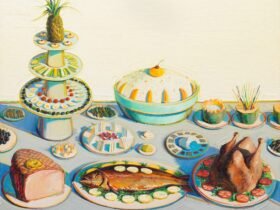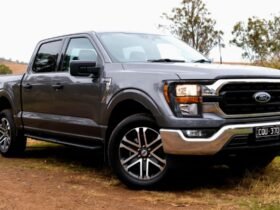In addition to the permanent exhibitions, the National Automobile Museum in Dietzhölztal, Germany, currently offers visitors an unforgettable journey through the history of one of the world’s most iconic car brands: Ferrari.
After ascending to the second floor of the museum, you will immediately be immersed in Ferrari’s legendary legacy, with a remarkable display of its most celebrated road and racing cars. From hypercars to championship-winning Formula 1 machines, rare custom builds and historic endurance racers, the exhibition captures the essence of Ferrari’s evolution. It’s a sensory feast, bringing together high-end engineering, stunning design and Maranello’s rich motorsport heritage.
The first exhibit that greets you is a tribute to Ferrari’s exclusive supercar line: the 288 GTO, F40, F50, Enzo and LaFerrari. It’s known as the ‘Big Five’, but with the recent unveiling of the F80 I suspect it will soon become the ‘Big Six’.
Each of these cars represents the pinnacle of design and performance in its time. The 288 GTO on display has a special history, because it was owned by Albert Uderzo, the French cartoonist and co-creator of Asterix.


Next to it is the F40, the least rare in the series, with 1,311 units produced. But for many enthusiasts, including myself, it is the most desirable. Limited to just 349 examples, the F50 is a true rarity, and the current exhibition includes one of only two factory-issued models with gold-coloured wheels, a nod to Ferrari’s vintage Formula 1 cars.

The Enzo marked the debut of the F140 engine: a naturally aspirated 6.0-liter V12 that drew heavily from Formula 1 technology and became the heart of Ferrari’s hypercar line. Not only did the F140 engine take the Enzo to a blistering 0-62mph time of 3.3 seconds, but it also laid the foundation for the hybrid-assisted F140 V12 in the LaFerrari, which sits next to it on display.

Two notable models from the 1970s loom large: the 1972 312B and the 1973 312 BB-74. The latter is especially important as it was the first Ferrari driven by the legendary Niki Lauda, who shared the car with drivers like Jacky Ickx, Clay Regazzoni and Arturo Merzario.

As I wandered deeper into the exhibition, I came across two more rare Ferrari race cars: the Mille Miglia-winning 1952 250 S – the only one of its kind – and the 275 S Spyder Vignale, which also took part in the same prestigious race.

The exhibition then moves on to Ferrari’s legacy of endurance racing, where one of the most beautiful racing cars ever made – the 330 P3 – takes center stage. This car competed at Le Mans in 1966 with the Ford GT40s driven by Lorenzo Bandini and Jean Guichet. By 1967 it had been modified with a Drogo body and was renamed the 412P, racing under the banner of the North American Racing Team with Pedro Rodríguez and Giancarlo Baghetti at the wheel. It took third place at the ’67 24 Hours of Daytona, contributing to Ferrari’s triple victory.

Nearby sits a rare and highly collectible 1966 Dino 206 S Spyder, one of only 18 ever built, and powered by a 2.0L V6 engine producing 220 horsepower.

Also on display is the F2004, the car that helped Michael Schumacher claim his fifth F1 World Championship with Ferrari. This machine achieved eight victories from 11 races. The F2004 is Ferrari’s most successful Formula 1 car, achieving 18 podium finishes from 18 races. For fans of Ferrari and Schumacher alike, this car embodies the pinnacle of the Scuderia’s dominance in F1.

Visible from outside the museum, the F2007 recalls another legendary moment in Ferrari history. This car commemorates Kimi Räikkönen’s exciting driver’s title from 2007, Ferrari’s most recent driver’s championship.

The Ferrari exhibition also features three custom Pininfarina masterpieces, including a 1957 250 GT Speciale, crafted for Princess Réthy, wife of Belgian King Leopold III, and a 1954 250 MM, originally commissioned by the wife of Baron Thyssen and later owned by Aga Khan. . Completing this rare collection is the 1961 250 GT Speciale, which debuted at the London Motor Show the same year.

In another corner, a unique replica of the pit box features a 1951 Ferrari 212 Inter – the first Ferrari racing car to arrive in America. This particular 212 finished second in the Carrera Panamericana, driven by Ascari and Villoresi, just behind an identical Ferrari driven by Taruffi and Chinetti, which no longer exists.


Two legendary Barchettas complete the collection: the Nürburgring-winning 275/330P from 1964 and the Dino 196/246 SP, Ferrari’s first mid-engine car that twice triumphed in the Targa Florio and won the European Hill Climb Championship in 1962.

The Ferrari exhibition at the Nationales Automuseum offers an immersive journey through Ferrari’s heritage. It is a celebration not only of Ferrari’s technological achievements, but also of the artistry and passion that have characterized the brand for more than 80 years. Check it out in person if you have the chance.
Vladimir Lyadov
Instagram: wheelsbywovka
because@wheelsbywovka.com
www.wheelsbywovka.com
Ferrari-related stories on Speedhunters





















Leave a Reply